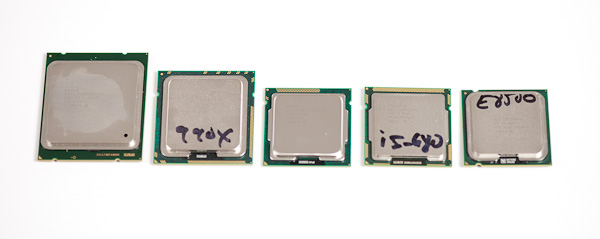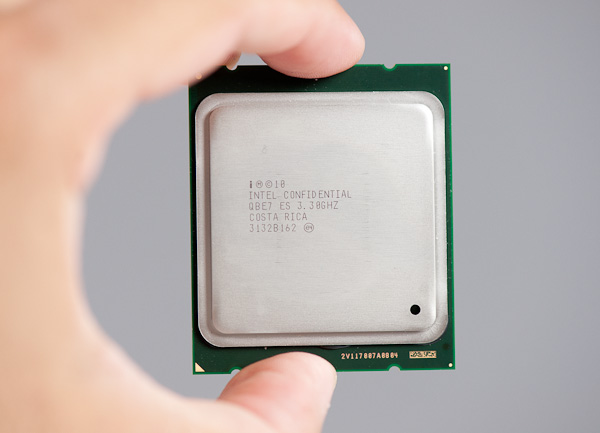Intel Core i7 3960X (Sandy Bridge E) Review: Keeping the High End Alive
by Anand Lal Shimpi on November 14, 2011 3:01 AM EST- Posted in
- CPUs
- Intel
- Core i7
- Sandy Bridge
- Sandy Bridge E
Final Words
There are two aspects of today's launch that bother me: the lack of Quick Sync and the chipset. The former is easy to understand. Sandy Bridge E is supposed to be a no-compromise, ultra high-end desktop solution. The lack of an on-die GPU with Quick Sync support means you have to inherently compromise in adopting the platform. I'm not sure what sort of a solution Intel could've come to (I wouldn't want to give up a pair of cores for a GPU+QuickSync) but I don't like performance/functionality tradeoffs with this class of product. Secondly, while I'm not a SAS user, I would've at least appreciated some more 6Gbps SATA ports on the chipset. Native USB 3.0 support would've been nice as well. Instead what we got was effectively a 6-series chipset with a new name. As Intel's flagship chipset, the X79 falls short.

From left to right: Intel Core i7 (SNB-E), Core i7 (Gulftown), Core i5 (SNB), Core i5 (Clarkdale), Core 2 Duo
LGA-2011, 1366, 1155, 1156, 775
The vast majority of desktop users, even enthusiast-class users, will likely have no need for Sandy Bridge E. The Core i7 3960X may be the world's fastest desktop CPU, but it really requires a heavily threaded workload to prove it. What the 3960X doesn't do is make your gaming experience any better or speed up the majority of desktop applications. The 3960X won't be any slower than the fastest Sandy Bridge CPUs, but it won't be tremendously faster either. The desktop market is clearly well served by Intel's LGA-1155 platform (and its lineage); LGA-2011 is simply a platform for users who need a true powerhouse.
There are no surprises there, we came to the same conclusion when we reviewed Intel's first 6-core CPU last year. If you do happen to have a heavily threaded workload that needs the absolute best performance, the Core i7 3960X can deliver. In our most thread heavy tests the 3960X had no problems outpacing the Core i7 2600K by over 50%. If your livelihood depends on it, the 3960X is worth its entry fee. I suspect for those same workloads, the 3930K will be a good balance of price/performance despite having a smaller L3 cache. I'm not terribly interested in next year's Core i7 3820. Its point is obviously for those users who need the memory bandwidth or PCIe lanes of SNB-E, but don't need more than four cores. I would've liked to have seen a value 6-core offering instead, but I guess with a 435mm2 die size it's a tough sell for Intel management.
Of course compute isn't the only advantage of the Sandy Bridge E platform. With eight DIMM slots on most high end LGA-2011 motherboards you'll be able to throw tons of memory at your system if you need it without having to shop for workstation motherboards with fewer frills.
As for the future of the platform, Intel has already begun talking about Ivy Bridge E. If it follows the pattern set for Ivy Bridge on LGA-1155, IVB-E should be a drop in replacement for LGA-2011 motherboards. The biggest issue there is timing. Ivy will arrive for the mainstream LGA-1155 platforms around the middle of 2012. At earliest, I don't know that we'd see it for LGA-2011 until the end of next year, or perhaps even early 2013 given the late launch of SNB-E. This seems to be the long-term downside to these ultra high-end desktop platforms these days: you end up on a delayed release cadence for each tick/tock on the roadmap. If you've always got to have the latest and greatest, this may prove to be frustrating. Based on what we know of Ivy Bridge however, I suspect that if you're using all six of these cores in SNB-E that you'll wish you had IVB-E sooner, but won't be tempted away from the platform by a quad-core Ivy Bridge on LGA-1155.
I do worry about the long term viability of the ultra high-end desktop platform. As we showed here, some of the gains in threaded apps exceed 50% over a standard Sandy Bridge. That's tangible performance to those who can use it. With the growth in cloud computing it's clear there's demand for these types of chips in servers. I just hope Intel continues to offer a version for desktop users as well.











163 Comments
View All Comments
mino - Monday, November 14, 2011 - link
"Quick Sync leverages the GPU's shader array"This is simply not true. And you know it. Shame.
Steelski - Tuesday, November 15, 2011 - link
irrelevant CS4 test because someone buying this kind of hardware would appreciate the CS5 advantage other websites show.jewie27 - Tuesday, November 15, 2011 - link
I was waiting for X79 but after I read the initial reviews I bought a Z68 motherboard and 2500K cpu for gaming.C300fans - Tuesday, November 15, 2011 - link
Me too. 999$+X79 for 0% improvement in gaming. What a crab! Bulludozer seems not that crab comparing to 3960x overall.yankeeDDL - Tuesday, November 15, 2011 - link
Making unsubstantiated claims about something that is non-intuitive falls, in my dictionary, under fanboy-ism (if that's a word).The fact that Win7 "runs better" on a certain, relatively old, PC, is one thing. Stating that Windows7 is faster than XP (in spite of a documented benchmark proving otherwise) is another one.
Like I said, you can compare OS in terms of HW support, ease of use, even responsiveness, however, neither of those translate into one OS beinf "faster".
Faster means that when you run a benchmark (pick any of the ones that Anand run in this article), you get a noticeable increase in speed.
The OSes provide the infrastructure to run applications, they cannot provide any fundamental speed difference, unless, of course, you have a PC without enough RAM, for example, and in that case the OS that uses less RAM will have an obvious advantage (because it offers more "free" RAM for apps to run), but that again, has nothing to do with one OS being faster: if anything, it is more efficient.
I have 4GB on both my laptop (Win7) and on my desktop (WinXP) and the difference is negligible: I nearly always have more than 2GB of RAM committed, so it is no surprise that on your PC Win7 with ReadyBoost is faster: just spend ~$15 on 2GB of RAM and you'll see a huge performance improvement both on XP and 7.
jmelgaard - Tuesday, November 15, 2011 - link
So "Faster" must not apply to the OS's capability to respond to the user, it must only apply to the OS's capability to server application requests?...Wait what?...
Kob - Tuesday, November 15, 2011 - link
You guys need to look at the engineering of your requests: 6 sata3 ports require feeding 6*6gb/s = 36 Gb/s data, while the total max theoretical mem bw of the chipset is 37 Gb/s. Can't do that while also taking care of OS, apps and video memory requirements.cbutters - Monday, December 12, 2011 - link
6*6gb/s isn't going to be happening constantly.....you build out one bridge that has a certain amount of bandwidth, 12GB perhaps, I don't know, and let the ports use the available shared bandwidth, doesn't mean you can't add additional ports, this is one of the benefits of serial interfaces.C300fans - Tuesday, November 15, 2011 - link
Intel Gulftown 6C 32nm 6 1.17B 240mm2Intel Sandy Bridge E (6C) 32nm 6 2.27B 435mm2
SB-E, What a crab! Double Transistors, Double size, merely 20% gain from SB 2600k. 999$ for this? I would rather get 2 pcs Interlagos 6200 instead.
sna1970 - Tuesday, November 15, 2011 - link
using 5870 CF to show us that dual 8x PCIE are same as dula 16x is a mistake I am shocked some one like you fall in ...you should have tested 6990 in CF , or 590 ... and see the difference between 16x SLI/CF and 8x SLI/CF
and how do you consider a 5870 a MODERN GPU ?
Quote : "Modern GPUs don't lose much performance in games, even at high quality settings, when going from a x16 to a x8 slot."
Answer : WRONG . try high end dual GPU cards in SLI/CF !